Contents
at the Siberian Research Institute. Lisavenko, on the basis of the Altai honeysuckle, a new variety Fire Opal was created. According to the results of variety testing in 2000, the variety of the crop was entered in the State Register with a recommendation for cultivation in the Siberian and Ural regions. Description of the variety of honeysuckle Fire Opal will help you get acquainted with the culture, learn about the features of its planting and cultivation.
Description of Honeysuckle Fire Opal
Fire Opal is a variety of honeysuckle with a medium early fruiting period. Berries reach biological ripeness in the second half of May.
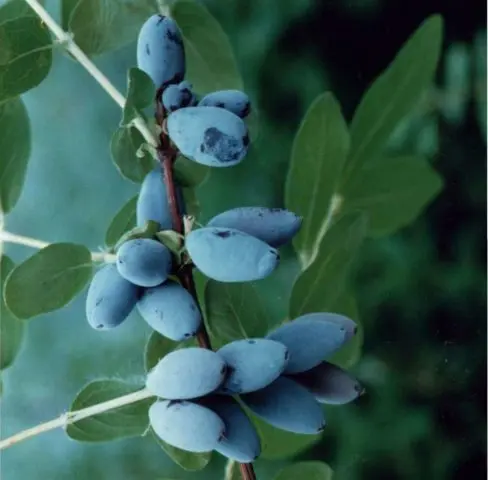
The berries of the Fire Opal variety are dark blue with a bluish coating.
On average, 4 kg of fruits are harvested from one bush, with proper agricultural technology, the yield increases to 6 kg. Variety Fire Opal refers to early maturing, the first flowering occurs in the fourth year of growth.
Honeysuckle Description:
- Fire opal grows in the form of a shrub, the height of which rarely exceeds 1,5 m. The density is medium, the branches are upright, the crown is spreading.
- The first 3 years of vegetation go to the formation of the root system, the growth of the aerial part is insignificant. Then the vegetation is directed to shoot formation and fruiting. During the season, the honeysuckle bush forms up to 45 young branches.
- The surface of the shoots of the current year is dark green with a brown tint, smooth. Over time, the color becomes gray, the bark exfoliates, rough.
- The foliage is dense, the leaf plate is dark green, convex or straight with rounded slightly lowered tops. Stipules are large, fused with the cutting, the edges are wavy.
- The flowers are simple, medium in size, light yellow. They are located on the tops of annual shoots in pairs in the leaf axils.
- The berries are broadly oval, up to 1,6 cm long. They grow densely, are well fixed to the stalk, do not crumble after ripening, separation is difficult, dry.

- The pulp is dense, juicy, beige, sweetish-sour, with insufficient illumination of the culture, a slight bitterness may be present in the taste of the berries.
- Honeysuckle fruits are versatile in processing, retain their nutritional value for a long time, and are characterized by high transportability.
Honeysuckle Fire Opal is one of the first on the site to bloom and bear fruit. The deciduous plant retains its decorative shape for a long time, the foliage turns brown and does not fall until the snow.
The fire opal variety is characterized by high winter hardiness, withstands temperatures as low as -35 °C. The culture is not afraid of a sharp drop in temperature after the start of sap flow. Winters well without additional shelter.
It tolerates moisture deficiency worse; cultivation in a southern climate requires additional watering. In dry summers, the yield drops due to small berries. Resistance to infections is high, it resists pests worse.
Planting and caring for the honeysuckle variety Fire Opal
According to the characteristics of the Fire Opal variety, the plant is quite unpretentious, it survives in any conditions. In order for the vegetation of the honeysuckle to be complete, and the shrub to give a high yield of berries with good taste, the biological requirements of the culture are taken into account when growing.
Terms of planting
The culture bears fruit on last year’s shoots, sap flow begins early, when the temperature reaches zero. Vegetation completely stops in the second half of August, since September the biological cycle stops. This is the best time to land. In a temperate climate, honeysuckle Fire Opal is placed on the site with the condition that the seedling has time to take root before the onset of frost, the approximate planting time is September.
Selection and preparation of the landing site
Particular attention is paid to the location of the Fire Opal variety. The plant is light-loving, at the same time it reacts badly to direct sunlight, the stems dry out, the bush becomes loose, the budding weakens. The fruits are formed small and sour.
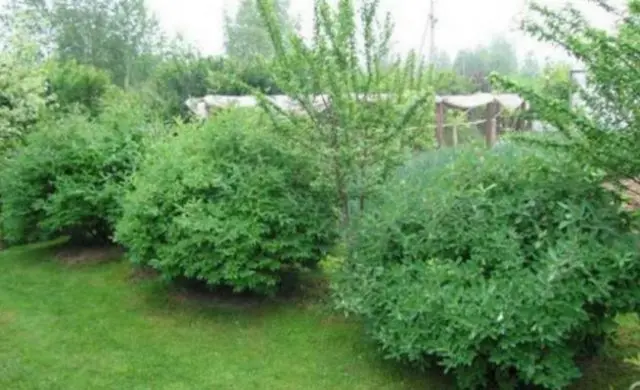
The site should be open, but with periodic shading
The best option is the south side behind the wall of the building, honeysuckle does not like drafts. A place near large fruit trees with a dense crown is not considered, here the culture will experience a lack of light, fruiting will drop sharply.
Variety Fire Opal grows best on neutral or slightly acidic soil. If the composition does not meet the requirements, it is corrected by making certain funds. Liming helps reduce acidity. You can acidify the soil with the help of coniferous litter, high-moor peat. The soil for planting honeysuckle is chosen fertile, light, aerated. Culture will not grow on sandstones; loamy soil or sandy loam will do. Soil moisture should be moderate, stagnation or high water occurrence for the Fire Opal variety is not suitable. For this reason, shrubs are not planted in lowlands or ravines.
A plot for honeysuckle is prepared at the time of planting or in advance. The soil is dug up, weeds are removed along with the roots. Dig a hole so that it is 10 cm wider than the root volume. The depth is chosen taking into account the drainage pad and the nutrient mixture layer. The root neck should not be sunk into the ground. The approximate depth of the landing hole is 50 cm.
Rules for planting Kamchatka honeysuckle Fire Opal
A seedling at least two years old, with several stems and a strong root system, is suitable for breeding honeysuckle. Before purchasing planting material, pay attention to the bark of the branches, it should be smooth, without damage.
Before planting, the open root is placed for 2 hours in a growth stimulant preparation.
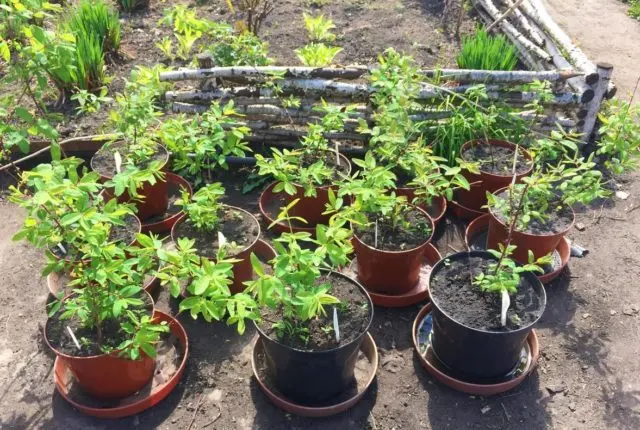
If the seedling is in a transport container, soaking can be omitted
The pot is filled with water before planting and the honeysuckle is removed. A nutrient substrate is prepared from peat, compost and soddy soil in equal proportions. Superphosphate is added to the mixture, if the composition of the soil is acidic – wood ash.
Landing algorithm:
- The bottom of the pit is covered with drainage.
- Top with part of the nutrient mixture.
- Honeysuckle is placed in the center, the roots are distributed along the bottom.
- Fall asleep with the rest of the substrate, compact, fill the pit to the top.
The plant is watered, mulched, cut the stems to 1/3 of the length. During mass planting, the distance between the pits is maintained at least 1,5 m.
Watering and feeding
The honeysuckle of the Fire Opal variety is characterized by medium drought resistance; the root ball should not be allowed to dry out. The plant is watered as needed to keep the soil moist but not waterlogged. For honeysuckle, aeration plays an important role, after watering a crust may form, it must be loosened. Young bushes are watered regularly, using a small amount of water. When watering adult honeysuckle, they are guided by precipitation.
If a nutrient mixture was used during planting, the Fire Opal variety does not need top dressing in the first two years. Fertilize the shrub from the third year of vegetation in 2 doses, in the spring they use organic matter and urea, in the fall – a complex of mineral fertilizers and compost.
Pruning Honeysuckle Fire Opal
The first pruning is carried out immediately after planting. Up to four years, only the upper part of the branches is removed so that the plant gives more shoots. In subsequent years of growth, pruning is carried out after picking berries, for good air circulation, old branches are removed in the central part of the bush.
The culture bears fruit on young shoots, old skeletal branches are replaced with new ones once every 1 years.
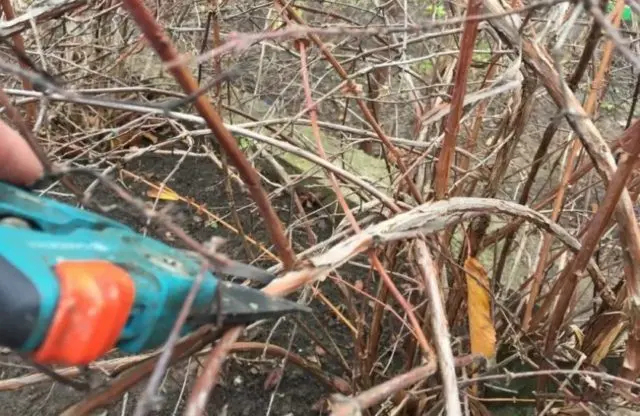
At the end of September, they make a sanitary cleaning of the bush, remove weak, curved stems growing inside the bush
Wintering
Frost-resistant honeysuckle Fire opal hibernates without crown shelter, you can mulch the near-trunk circle. The adult culture is pruned, water-charging irrigation is carried out, and this is where the preparatory measures end.
Seedlings with an unformed root system without shelter may die. During the winter, the following activities are carried out:
- spud, cover with a layer of mulch;
- if abnormal frosts are expected, the crown is collected in a bunch;
- wrapped with covering material;
- cover with spruce.
Reproduction
Breeding varieties, which include Fire Opal, are not customary to propagate by seeds on their own. The process is lengthy, and the result can be unpredictable.
The culture is bred vegetatively. The most suitable option is cuttings. The material is harvested in the spring from last year’s shoots. Placed in the ground, the following autumn, rooted cuttings are planted on the site.
Honeysuckle can be propagated by layering. The lower stiff stem is dug into the ground. In place of vegetative buds, root shoots will appear by autumn. In the spring it will be seen from the sprouts which parts are rooted. Around the beginning of September they are seated.
Honeysuckle Pollinators Fire Opal
The plant is not self-fertile, it is pollinated by hawk moths, bumblebees and bees. To attract pollinators, the plant is sprayed with sugar syrup at the beginning of flowering.
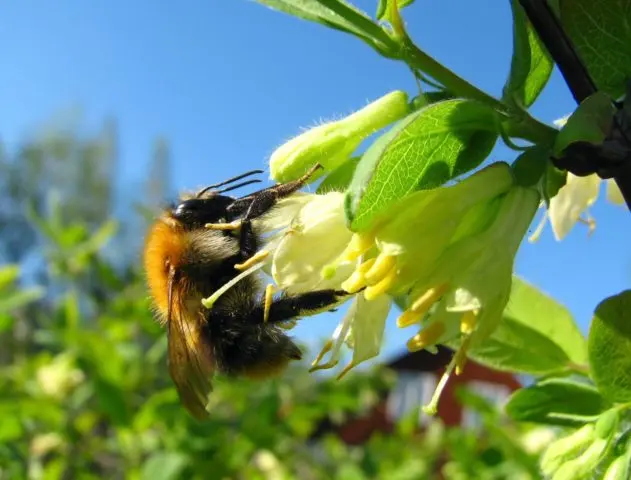
The most common pollinators of honeysuckle are bees.
As varieties of pollinators, honeysuckle is planted on the site with the same flowering time. For Fire Opal, Morena, Kamchadalka, Blue Spindle varieties are suitable.
Diseases and pests
Cultivar Fire Opal can be affected by powdery mildew. Fungal infection spreads in high soil moisture. To eliminate the disease, watering is reduced, damaged areas are cut off, the shrub is treated with Topaz.
Of the pests, willow scale insects, leafworms and aphids are of particular danger to the plant. At the beginning of the season, for prevention, they are treated with Bordeaux liquid, if insects are found with Fitoverm or insecticides.
Conclusion
Description of the honeysuckle variety Fire Opal reveals the biological characteristics of the culture. Compliance with agricultural technology will be the key to the formation of a healthy plant with high yields and a decorative crown. Preventive measures will prevent the development of infection and the spread of pests.










